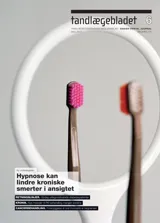Effect of hypnotic pain modulation on brain activity in patients with temporomandibular disorder pain
Effekt af hypnotisk smertemodulation på hjerneaktivitet hos patienter med kroniske myofasciale temporomandibulære smerter (TMD)
Hypnose kan påvirke smerteopfattelsen, men der eksisterer kun lidt viden om de dertil knyttede centrale processer i hjernen hos patienter med kroniske smertetilstande. Hjerneaktivitet fremkaldt af gentagen smertestimulation (pinprick) over venstre nervus mentalis blev undersøgt ved hjælp af funktionel magnetisk resonans billeddiagnostik hos 19 TMD patienter i kontroltilstand (baseline) og under hypnotisk hypoalgesi eller hypnotisk hyperalgesi. Selv-rapporteret smerteintensitet og ubehag ved den samme smertestimulation blev registreret på en skala fra 0-10 (Numerical Rating Scale (NRS)). NRS smerter og ubehag var henholdvis væsentligt lavere under hypnotisk hypoalgesi og markant højere under hypnotiske hyperalgesi end ved baseline. I kontroltilstanden resulterede den smertefulde stimulering i aktivering af højre posterior insula, primær somatosensoriske corteks (SI), BA21, og BA6, samt venstre BA40 og BA4. Samme smertestimulation under hypnotisk hyperalgesi var forbundet med forøget aktivitet i højre posterior insula og BA6 samt venstre BA40, mens der under hypnotisk hypoalgesi kun blev registreret aktivitet i højre posterior insula. Uventet viste den direkte statistiske sammenligning mellem de 2 tilstande, baseline og hypnotisk hyperalgesi, et signifikant fald i S1 under hyperalgesi i forhold til baseline. Den direkte sammenligning mellem de 2 tilstande, baseline og hypnotisk hypoalgesi, viste signifikant reduktion af aktiviteten i højre posterior insula og BA21, samt venstre BA40 under hypoalgesi i forhold til baseline. Disse resultater er de første til at påvise hypnotisk modulation af hjerneaktiviteten hos kroniske TMD patienter er associeret til smerteoplevelsen. Endvidere ses at hypnotisk hypoalgesi er forbundet med en markant undertrykkelse af den kortikale aktivitet. Desuden ses en uoverensstemmelse mellem selv-rapporteret scores og kortikal aktivitet i S1 under hypnotisk hyperalgesi
Hypnosis modulates pain perception, but the associated brain mechanisms in chronic pain conditions are poorly understood. Brain activity evoked by painful repetitive pin-prick stimulation of the left mental nerve region was investigated with use of functional magnetic resonnance imaging in 19 patients with painful temporomandibular disorders (TMD) during hypnotic hypoalgesia and hyperalgesia and a control condition. Pain intensity and unpleasantness of the painful stimulation was scored on a 0-10 Numerical Rating Scale (NRS). NRS pain and unpleasantness scores during hypnotic hypoalgesia were significantly lower than in the control condition and significantly higher in the hypnotic hyperalgesia condition. In the control condition, painful stimulation caused significant activation of right posterior insula, primary somatosensory cortex (SI), BA21, and BA6, and left BA40 and BA4. Painful stimulation during hypnotic hyperalgesia was associated with increased activity in right posterior insula and BA6 and left BA40 whereas hypnotic hypoalgesia only was associated with activity in right posterior insula. Unexpectedly, direct contrasts between control and hypnotic hyperalgesia conditions revealed significant decreases in S1 during hyperalgesia. Direct contrasts between control and hypnotic hypoalgesia conditions demonstrated significant decreases in right posterior insula and BA21, as well as left BA40 during hypoalgesia. These findings are the first to describe hypnotic modulation of brain activity associated with nociceptive processing in chronic TMD pain patients and demonstrate that hypnotic hypoalgesia is associated with a pronounced suppression of cortical activity and a disconnection between patient-based scores and cortical activity in S1 during hypnotic hyperalgesia.


